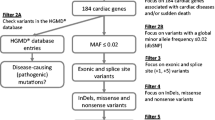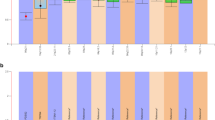Abstract
Sudden cardiac death (SCD) is one of the major causes of mortality worldwide, mostly involving coronary artery disease in the elderly. In contrary, sudden death events in young victims often represent the first manifestation of undetected genetic cardiac diseases, which remained without any symptoms during lifetime. Approximately 30% of these sudden death cases have no definite cardiac etiology after a comprehensive medicolegal investigation and are therefore termed as sudden unexplained death (SUD) cases. Advances in high-throughput sequencing approaches have provided an efficient diagnostic tool to identify likely pathogenic variants in cardiovascular disease-associated genes in otherwise autopsy-negative SUD cases. The aim of this study was to genetically investigate a cohort of 34 unexplained death cases by focusing on candidate genes associated with cardiomyopathies and channelopathies. Exome analysis identified potentially disease-causing sequence alterations in 29.4% of the 34 SUD cases. Six (17.6%) individuals had variants with likely functional effects in the channelopathy-associated genes AKAP9, KCNE5, RYR2, and SEMA3A. Interestingly, four of these six SUD individuals were younger than 18 years of age. Since the total SUD cohort of this study included five children and adolescents, post-mortem molecular autopsy screening indicates a high diagnostic yield within this age group. Molecular genetic testing represents a valuable approach to uncover the cause of death in some of the SUD victims; however, 70–80% of the cases still remain elusive, emphasizing the importance of additional research to better understand the pathological mechanisms leading to a sudden death event.
Similar content being viewed by others
References
Chugh SS, Kelly KL, Titus JL (2000) Sudden cardiac death with apparently normal heart. Circulation 102(6):649–654. https://doi.org/10.1161/01.CIR.102.6.649
Ackerman MJ, Priori SG, Willems S, Berul C, Brugada R, Calkins H, Camm AJ, Ellinor PT, Gollob M, Hamilton R, Hershberger RE, Judge DP, Le Marec H, McKenna WJ, Schulze-Bahr E, Semsarian C, Towbin JA, Watkins H, Wilde A, Wolpert C, Zipes DP, Heart Rhythm S, European Heart Rhythm A (2011) HRS/EHRA expert consensus statement on the state of genetic testing for the channelopathies and cardiomyopathies: this document was developed as a partnership between the Heart Rhythm Society (HRS) and the European Heart Rhythm Association (EHRA). Heart Rhythm 8(8):1308–1339. https://doi.org/10.1093/europace/eur245
Hofer F, Fellmann F, Schläpfer J, Michaud K (2014) Sudden cardiac death in the young (5-39 years) in the canton of Vaud, Switzerland. Cardiovasc Disord 14(140):1471–2261
Rodriguez-Calvo MS, Brion M, Allegue C, Concheiro L, Carracedo A (2008) Molecular genetics of sudden cardiac death. Forensic Sci Int 182(1–3):1–12. https://doi.org/10.1016/j.forsciint.2008.09.013
Abriel H, Zaklyazminskaya EV (2013) Cardiac channelopathies: genetic and molecular mechanisms. Gene 517(1):1–11. https://doi.org/10.1016/j.gene.2012.12.061
Elliott P, Andersson B, Arbustini E, Bilinska Z, Cecchi F, Charron P, Dubourg O, Kühl U, Maisch B, McKenna WJ, Moserrat L, Pankuweit S, Rapezzi C, Seferovic P, Tavazzi L, Keren A (2008) Classification of the cardiomyopathies: a position statement from the European Society of Cardiology Working Group on myocardial and pericardial diseases. Eur Heart J 29:270–276. https://doi.org/10.1093/eurheartj/ehm342
Campuzano O, Alcalde M, Berne P, Castro V, Guzzo G, Iglesias A, Alonso-Pulpon L, Garcia-Pavia P, Brugada J, Brugada R (2012) Genetic testing of candidate genes in arrhythmogenic right ventricular cardiomyopathy/dysplasia. Eur J Med Genet 55(4):225–234. https://doi.org/10.1016/j.ejmg.2012.02.007
Tester DJ, Ackerman MJ (2006) The role of molecular autopsy in unexplained sudden cardiac death. Curr Opin Cardiol 21(3):166–172. https://doi.org/10.1097/01.hco.0000221576.33501.83
Santori M, Blanco-Verea A, Gil R, Cortis J, Becker K, Schneider PM, Carracedo A, Brion M (2015) Broad-based molecular autopsy: a potential tool to investigate the involvement of subtle cardiac conditions in sudden unexpected death in infancy and early childhood. Arch Dis Child 100(10):952–956. https://doi.org/10.1136/archdischild-2015-308200
Loporcaro CG, Tester DJ, Maleszewski JJ, Kruisselbrink T, Ackerman MJ (2013) Confirmation of cause and manner of death via a comprehensive cardiac autopsy including whole exome next-generation sequencing. Arch Pathol Lab Med 138(8):1083–1089. https://doi.org/10.5858/arpa.2013-0479-SA
Narula N, Tester DJ, Paulmichl A, Maleszewski JJ, Ackerman MJ (2014) Post-mortem whole exome sequencing with gene-specific analysis for autopsy-negative sudden unexplained death in the young: a case series. Pediatr Cardiol 36(4):768–778. https://doi.org/10.1007/s00246-014-1082-4
Hertz CL, Christiansen SL, Ferrero-Miliani L, Fordyce SL, Dahl M, Holst AG, Ottesen GL, Frank-Hansen R, Bundgaard H, Morling N (2015) Next-generation sequencing of 34 genes in sudden unexplained death victims in forensics and in patients with channelopathic cardiac diseases. Int J Legal Med 129(4):793–800. https://doi.org/10.1007/s00414-014-1105-y
Neubauer J, Haas C, Bartsch C, Medeiros-Domingo A, Berger W (2016) Post-mortem whole-exome sequencing (WES) with a focus on cardiac disease-associated genes in five young sudden unexplained death (SUD) cases. Int J Legal Med 130(4):1011–1021. https://doi.org/10.1007/s00414-016-1317-4
Anderson JH, Tester DJ, Melissa L, Ackerman MJ (2016) Whole-exome molecular autopsy after exertion-related sudden unexplained death in the young. Circ Cardiovasc Genet 9(3):260–265. https://doi.org/10.1161/CIRCGENETICS.115.001370
Christiansen SL, Hertz CL, Ferrero-Miliani L, Dahl M, Weeke PE, LuCamp OGL, Frank-Hansen R, Bundgaard H, Morling N (2016) Genetic investigation of 100 heart genes in sudden unexplained death victims in a forensic setting. Eur J Hum Genet 24(12):1797–1802. https://doi.org/10.1038/ejhg.2016.118
Neubauer J, Lecca MR, Russo G, Bartsch C, Medeiros-Domingo A, Berger W, Haas C (2017) Post-mortem whole-exome analysis in a large sudden infant death syndrome cohort with a focus on cardiovascular and metabolic genetic diseases. Eur J Hum Genet 25(4):404–409. https://doi.org/10.1038/ejhg.2016.199
Li H, Durbin R (2010) Fast and accurate long-read alignment with burrows-wheeler transform. Bioinformatics 26(5):589–595. https://doi.org/10.1093/bioinformatics/btp698
McKenna A, Hanna M, Banks E, Sivachenko A, Cibulskis K, Kernytsky A, Garimella K, Altshuler D, Gabriel S, Daly M, DePristo MA (2010) The genome analysis toolkit: a MapReduce framework for analyzing next-generation DNA sequencing data. Genome Res 20(9):1297–1303. https://doi.org/10.1101/gr.107524.110
DePristo MA, Banks E, Poplin R, Garimella KV, Maguire JR, Hartl C, Philippakis AA, del Angel G, Rivas MA, Hanna M, McKenna A, Fennell TJ, Kernytsky AM, Sivachenko AY, Cibulskis K, Gabriel SB, Altshuler D, Daly MJ (2011) A framework for variation discovery and genotyping using next-generation DNA sequencing data. Nat Genet 43(5):491–498. https://doi.org/10.1038/ng.806
Richards S, Aziz N, Bale S, Bick D, Das S, Gastier-Foster J, Grody WW, Hegde M, Lyon E, Spector E, Voelkerding K, Rehm HL, Committee ALQA (2015) Standards and guidelines for the interpretation of sequence variants: a joint consensus recommendation of the American College of Medical Genetics and Genomics and the Association for Molecular Pathology. Genet Med 17(5):405–424. https://doi.org/10.1038/gim.2015.30
Zeek PM (1942) Heart weight I. The weight of the normal human heart. Arch Pathol 34:820–832
Tester DJ, Ackerman MJ (2012) The molecular autopsy: should the evaluation continue after the funeral? Pediatr Cardiol 33(3):461–470. https://doi.org/10.1007/s00246-012-0160-8
Bagnall RD, Das KJ, Duflou J, Semsarian C (2014) Exome analysis-based molecular autopsy in cases of sudden unexplained death in the young. Heart Rhythm 11(4):655–662. https://doi.org/10.1016/j.hrthm.2014.01.017
Tester DJ, Medeiros-Domingo A, Will ML, Haglund CM, Ackerman MJ (2012) Cardiac channel molecular autopsy: insights from 173 consecutive cases of autopsy-negative sudden unexplained death referred for postmortem genetic testing. Mayo Clin Proc 87(6):524–539. https://doi.org/10.1016/j.mayocp.2012.02.017
Fill M, Copello JA (2002) Ryanodine receptor calcium release channels. Physiol Rev 82(4):893–922. https://doi.org/10.1152/physrev.00013.2002
Giannini G, Conti A, Mammarella S, Scrobogna M, Sorrentino V (1995) The ryanodine receptor/calcium channel genes are widely and differentially expressed in murine brain and peripheral tissues. J Cell Biol 128(5):893–904
Glasscock E (2014) Genomic biomarkers of SUDEP in brain and heart. Epilepsy Behav 38:172–179. https://doi.org/10.1016/j.yebeh.2013.09.019
Postma AV, Denjoy I, Kamblock J, Alders M, Lupoglazoff JM, Vaksmann G, Dubosq-Bidot L, Sebillon P, Mannens MM, Guicheney P, Wilde AA (2005) Catecholaminergic polymorphic ventricular tachycardia: RYR2 mutations, bradycardia, and follow up of the patients. J Med Genet 42(11):863–870. https://doi.org/10.1136/jmg.2004.028993
Swalwell H, Kirby DM, Blakely EL, Mitchell A, Salemi R, Sugiana C, Compton AG, Tucker EJ, Ke BX, Lamont PJ, Turnbull DM, McFarland R, Taylor RW, Thorburn DR (2011) Respiratory chain complex I deficiency caused by mitochondrial DNA mutations. Eur J Hum Genet 19(7):769–775. https://doi.org/10.1038/ejhg.2011.18
Lehnart SE, Mongillo M, Bellinger A, Lindegger N, Chen BX, Hsueh W, Reicken S, Wronska A, Drew LJ, Ward CW, Lederer WJ, Kass RS, Morley G, Marks AR (2008) Leaky Ca2+ release channel/ryanodine receptor 2 causes seizures and sudden cardiac death in mice. J Clin Invest 18(6):2230–2245. https://doi.org/10.1172/jci35346ds1
Chen L, Marquardt ML, Tester DJ, Sampson KJ, Ackerman MJ, Kass RS (2007) Mutation of an A-kinase-anchoring protein causes long-QT syndrome. Proc Natl Acad Sci U S A 104(52):20990–20995. https://doi.org/10.1073/pnas.0710527105
de Villiers CP, van der Merwe L, Crotti L, Goosen A, George AL Jr, Schwartz PJ, Brink PA, Moolman-Smook JC, Corfield VA (2014) AKAP9 is a genetic modifier of congenital long-QT syndrome type 1. Circ Cardiovasc Genet 7(5):599–606. https://doi.org/10.1161/CIRCGENETICS.113.000580
Anderson JH, Bos JM, Meyer FB, Cascino GD, Ackerman MJ (2012) Concealed long QT syndrome and intractable partial epilepsy: a case report. Mayo Clin Proc 87(11):1128–1131. https://doi.org/10.1016/j.mayocp.2012.07.019
Ohno S, Zankov DP, Ding WG, Itoh H, Makiyama T, Doi T, Shizuta S, Hattori T, Miyamoto A, Naiki N, Hancox JC, Matsuura H, Horie M (2011) KCNE5 (KCNE1L) variants are novel modulators of Brugada syndrome and idiopathic ventricular fibrillation. Circ Arrhythm Electrophysiol 4(3):352–361. https://doi.org/10.1161/CIRCEP.110.959619
Yazdani U, Terman JR (2006) The semaphorins. Genome Biol 7(3):211. https://doi.org/10.1186/gb-2006-7-3-211
Boczek NJ, Ye D, Johnson EK, Wang W, Crotti L, Tester DJ, Dagradi F, Mizusawa Y, Torchio M, Alders M, Giudicessi JR, Wilde AA, Schwartz PJ, Nerbonne JM, Ackerman MJ (2014) Characterization of SEMA3A-encoded semaphorin as a naturally occurring Kv4.3 protein inhibitor and its contribution to Brugada syndrome. Circ Res 115(4):460–469. https://doi.org/10.1161/CIRCRESAHA.115.303657
Brugada R, Campuzano O, Sarquella-Brugada G, Brugada J, Brugada P (2014) Brugada syndrome. Methodist Debakey Cardiovasc J 10(1):25–28. https://doi.org/10.14797/mdcj-10-1-25
Bagnall RD, Weintraub RG, Ingles J, Duflou J, Yeates L, Lam L, Davis AM, Thompson T, Connell V, Wallace J, Naylor C, Crawford J, Love DR, Hallam L, White J, Lawrence C, Lynch M, Morgan N, James P, du Sart D, Puranik R, Langlois N, Vohra J, Winship I, Atherton J, McGaughran J, Skinner JR, Semsarian C (2016) A prospective study of sudden cardiac death among children and young adults. N Engl J Med 374(25):2441–2452. https://doi.org/10.1056/NEJMoa1510687
Andreasen C, Nielsen JB, Refsgaard L, Holst AG, Christensen AH, Andreasen L, Sajadieh A, Haunso S, Svendsen JH, Olesen MS (2013) New population-based exome data are questioning the pathogenicity of previously cardiomyopathy-associated genetic variants. Eur J Hum Genet 21(9):918–928. https://doi.org/10.1038/ejhg.2012.283
Ghouse J, Have CT, Weeke P, Bille Nielsen J, Ahlberg G, Balslev-Harder M, Appel EV, Skaaby T, Olesen SP, Grarup N, Linneberg A, Pedersen O, Haunso S, Hastrup Svendsen J, Hansen T, Kanters JK, Salling Olesen M (2015) Rare genetic variants previously associated with congenital forms of long QT syndrome have little or no effect on the QT interval. Eur Heart J 36(37):2523–2529. https://doi.org/10.1093/eurheartj/ehv297
Nouhravesh N, Ahlberg G, Ghouse J, Andreasen C, Svendsen JH, Haunso S, Bundgaard H, Weeke PE, Olesen MS (2016) Analyses of more than 60,000 exomes questions the role of numerous genes previously associated with dilated cardiomyopathy. Mol Genet Genomic Med 4(6):617–623. https://doi.org/10.1002/mgg3.245
MacArthur DG, Manolio TA, Dimmock DP, Rehm HL, Shendure J, Abecasis GR, Adams DR, Altman RB, Antonarakis SE, Ashley EA, Barrett JC, Biesecker LG, Conrad DF, Cooper GM, Cox NJ, Daly MJ, Gerstein MB, Goldstein DB, Hirschhorn JN, Leal SM, Pennacchio LA, Stamatoyannopoulos JA, Sunyaev SR, Valle D, Voight BF, Winckler W, Gunter C (2014) Guidelines for investigating causality of sequence variants in human disease. Nature 508(7497):469–476. https://doi.org/10.1038/nature13127
Kuster DW, Mulders J, Ten Cate FJ, Michels M, Dos Remedios CG, Da Costa Martins PA, van de Velden J, Oudejans CB (2013) MicroRNA transcriptome profiling in cardiac tissue of hypertrophic cardiomyopathy patients with MYBPC3 mutations. J Mol Cell Cardiol 65:59–66. https://doi.org/10.1016/j.yjmcc.2013.09.012
Acknowledgments
This project was supported by the Swiss National Science Foundation (SNF; project-Nr. 320030_149456). Special thanks to Corinne Moser for DNA extractions and Sanger sequencing.
Author information
Authors and Affiliations
Corresponding author
Ethics declarations
Conflict of interest
The authors declare that they have no competing interests.
Ethical approval
All procedures performed in studies involving human participants were in accordance with the ethical standards of the institutional and/or national research committee and with the 1964 Helsinki Declaration and its later amendments or comparable ethical standards.
Electronic supplementary material
ESM 1
(PDF 230 kb).
Rights and permissions
About this article
Cite this article
Neubauer, J., Lecca, M.R., Russo, G. et al. Exome analysis in 34 sudden unexplained death (SUD) victims mainly identified variants in channelopathy-associated genes. Int J Legal Med 132, 1057–1065 (2018). https://doi.org/10.1007/s00414-018-1775-y
Received:
Accepted:
Published:
Issue Date:
DOI: https://doi.org/10.1007/s00414-018-1775-y




